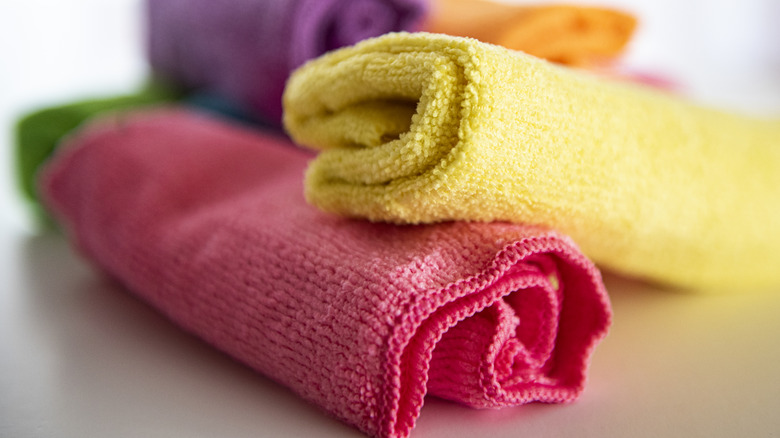This Small Detail On Your Microfiber Cloths Could Be Ruining Your Cleaning Routine
We may receive a commission on purchases made from links.
The fine fibers and high absorbency of microfiber cloths make them great for cleaning around the house. But sometimes when you use one to wipe up a smudge, you find that there's still a smudge left, or you may even spot new smudges and streaks. What gives? If your microfiber cloth isn't cleaning as well as you want, look closer at the fabric — literally. Specifically, look at the edge of the towel. Does it have stitching or a fabric band around the border? If so, that may be the culprit of the streaks left behind when you use it for cleaning or polishing.
Most microfiber products are sewn around the edges with an overlock stitch. It's a stable way of using polyester thread to seal the edges of the fabric and protect from fraying while still allowing some stretch, but that stitching may leave smudges when that part of the cleaning rag touches a surface. It can also cause scratches if you're cleaning delicate surfaces. Some microfiber cloths are made with edge banding, which means they have a thin strip of fabric sewn around the edge. If the band is made of polyester, you'll have the same streaking problem, but if it's made from microfiber, the towel will probably be gentler on surfaces, reducing the risk of smudges or scratches. There is also another option that will solve this problem entirely: edgeless microfiber cloths.
Clean with an edgeless microfiber cloth
Microfiber cloths with an edge will get the job done fine if you're just using them to dust. But if you're cleaning with chemicals or polishing streak-prone surfaces, you might want to swap them for a different option. Look for the ultimate solution to streaky cleaning marks: microfiber cloths with no stitching around the edge, like The Rag Company edgeless microfiber towels.
The edges (or lack thereof) on this type of microfiber are cut ultrasonically. The process uses a high-frequency vibrating blade to slice the fabric without applying heavy pressure or too much heat. It produces just enough heat to seal the edges of the material to prevent fraying. This type of microfiber towel is often advertised for auto detailing, but the uses don't stop there — their ability to polish streak-sensitive surfaces, like windshields, without leaving smudges can carry over to polishing items around your home, too.
It's fairly easy to tell edgeless microfiber cloths from other microfiber towels just by looking at them closely. High-quality edgeless microfiber products have smooth sides free of loose fibers and no visible stitching with a dense weave and a soft feel. If you want to make the difference between your edgeless and stitched towels even more obvious, you can color code your microfiber cloths for extra organization. Be sure to wash them after every use just like any other cleaning tool, and avoid these common laundry mistakes that could ruin your microfiber cloth.

